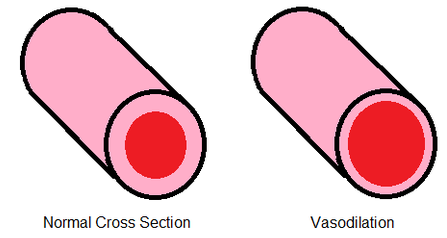Spirulina for this, spirulina for that. It seems like this whole spirulina thing might be getting a little  carried away. Now its spirulina for blood pressure?
carried away. Now its spirulina for blood pressure?
I know how it sounds but the truth is that spirulina is effective at reducing blood pressure, which can increase the risk of heart disease, liver damage, stroke, etc. And there are studies to back up this claim. Its not just a rumor.
One of the ways that spirulina decreases blood pressure is through nitric oxide production.
Spirulina increases nitric oxide (NO) production
Nitric oxide is a gas molecule that your body synthesizes. It acts as a blood pressure regulator, widening blood vessels and increasing blood flow. With thousands of studies done on NO, its benefits are well known and documented.
Because it increases the diameter of blood vessels (dilates them), which in turn increases blood flow, more oxygen is able to get to your organs. Increasing NO production is used for a number of different conditions such as heart problems, erectile disfunction, etc.
As you can guess, when NO widens your blood vessels and the blood flow increases, your blood pressure decreases.
There have been several studies performed on the blood pressure effects of spirulina,
One of which was conducted on 36 subjects including men and women, studied blood lipids, glucose, and pressure before and throughout 6 weeks of supplementing 4.5 grams of spirulina per day. The results of this added supplementation, which are published in BioMed Central, showed that spirulina is effective at reducing blood pressure [2].
But HOW does it decrease blood pressure?
Another study, this one published in the Journal of Medicinal Food, strongly suggests 2 reasons for spirulina’s ability to increase NO production and dilate blood vessels.
The exact pathway that spirulina is able to increase NO production is still undetermined, but it does so through the endothelium, which is the inner lining of blood vessels. The reason that spirulina is able to dilate blood vessels, increasing blood flow, is because it increases the release of a vasodilating cyclooxygenase-dependent metabolite of arachidonic acid [1].
Dosage
The 4.5 grams/day that was used in the study mentioned above is an adequate dosage for reducing blood pressure. It is far from being too much and can be taken safely.
It is also suggested that lower amounts such as 3.5g/day would also benefit blood pressure.
SO GIVE IT A TRY!
==> To Find Top Rated Spirulina Products CLICK HERE <==
If you have any questions or comments leave them in the comment section below please!
Sources
- 1)Juárez-Oropeza MA, Mascher D, Torres-Durán PV, Farias JM, Paredes-Carbajal MC. J Med Food. 2009 Feb;12(1):15-20. doi: 10.1089/jmf.2007.0713.
- 2)Torres-Duran PV, Ferreira-Hermosillo A, Juarez-Oropeza MA. Antihyperlipemic and antihypertensive effects of Spirulina maxima in an open sample of mexican population: a preliminary report. Lipids in Health and Disease. 2007;6:33. doi:10.1186/1476-511X-6-33.

Like I said Spirulina is completely new to me. Never heard of it before. Entirely natural medicine that regulates blood pressure. Wonderful!
Damir
Absolutely. It has many other benefits as well